Michal Irani
KernelFusion: Assumption-Free Blind Super-Resolution via Patch Diffusion
Mar 27, 2025Abstract:Traditional super-resolution (SR) methods assume an ``ideal'' downscaling SR-kernel (e.g., bicubic downscaling) between the high-resolution (HR) image and the low-resolution (LR) image. Such methods fail once the LR images are generated differently. Current blind-SR methods aim to remove this assumption, but are still fundamentally restricted to rather simplistic downscaling SR-kernels (e.g., anisotropic Gaussian kernels), and fail on more complex (out of distribution) downscaling degradations. However, using the correct SR-kernel is often more important than using a sophisticated SR algorithm. In ``KernelFusion'' we introduce a zero-shot diffusion-based method that makes no assumptions about the kernel. Our method recovers the unique image-specific SR-kernel directly from the LR input image, while simultaneously recovering its corresponding HR image. KernelFusion exploits the principle that the correct SR-kernel is the one that maximizes patch similarity across different scales of the LR image. We first train an image-specific patch-based diffusion model on the single LR input image, capturing its unique internal patch statistics. We then reconstruct a larger HR image with the same learned patch distribution, while simultaneously recovering the correct downscaling SR-kernel that maintains this cross-scale relation between the HR and LR images. Empirical results show that KernelFusion vastly outperforms all SR baselines on complex downscaling degradations, where existing SotA Blind-SR methods fail miserably. By breaking free from predefined kernel assumptions, KernelFusion pushes Blind-SR into a new assumption-free paradigm, handling downscaling kernels previously thought impossible.
Don't Judge Before You CLIP: A Unified Approach for Perceptual Tasks
Mar 17, 2025Abstract:Visual perceptual tasks aim to predict human judgment of images (e.g., emotions invoked by images, image quality assessment). Unlike objective tasks such as object/scene recognition, perceptual tasks rely on subjective human assessments, making its data-labeling difficult. The scarcity of such human-annotated data results in small datasets leading to poor generalization. Typically, specialized models were designed for each perceptual task, tailored to its unique characteristics and its own training dataset. We propose a unified architectural framework for solving multiple different perceptual tasks leveraging CLIP as a prior. Our approach is based on recent cognitive findings which indicate that CLIP correlates well with human judgment. While CLIP was explicitly trained to align images and text, it implicitly also learned human inclinations. We attribute this to the inclusion of human-written image captions in CLIP's training data, which contain not only factual image descriptions, but inevitably also human sentiments and emotions. This makes CLIP a particularly strong prior for perceptual tasks. Accordingly, we suggest that minimal adaptation of CLIP suffices for solving a variety of perceptual tasks. Our simple unified framework employs a lightweight adaptation to fine-tune CLIP to each task, without requiring any task-specific architectural changes. We evaluate our approach on three tasks: (i) Image Memorability Prediction, (ii) No-reference Image Quality Assessment, and (iii) Visual Emotion Analysis. Our model achieves state-of-the-art results on all three tasks, while demonstrating improved generalization across different datasets.
Reconstructing Training Data From Real World Models Trained with Transfer Learning
Jul 22, 2024Abstract:Current methods for reconstructing training data from trained classifiers are restricted to very small models, limited training set sizes, and low-resolution images. Such restrictions hinder their applicability to real-world scenarios. In this paper, we present a novel approach enabling data reconstruction in realistic settings for models trained on high-resolution images. Our method adapts the reconstruction scheme of arXiv:2206.07758 to real-world scenarios -- specifically, targeting models trained via transfer learning over image embeddings of large pre-trained models like DINO-ViT and CLIP. Our work employs data reconstruction in the embedding space rather than in the image space, showcasing its applicability beyond visual data. Moreover, we introduce a novel clustering-based method to identify good reconstructions from thousands of candidates. This significantly improves on previous works that relied on knowledge of the training set to identify good reconstructed images. Our findings shed light on a potential privacy risk for data leakage from models trained using transfer learning.
The Wisdom of a Crowd of Brains: A Universal Brain Encoder
Jun 18, 2024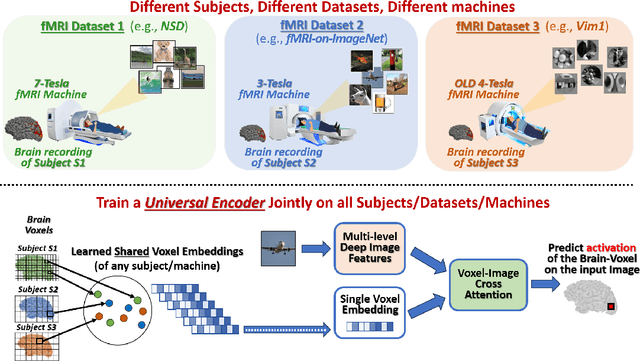
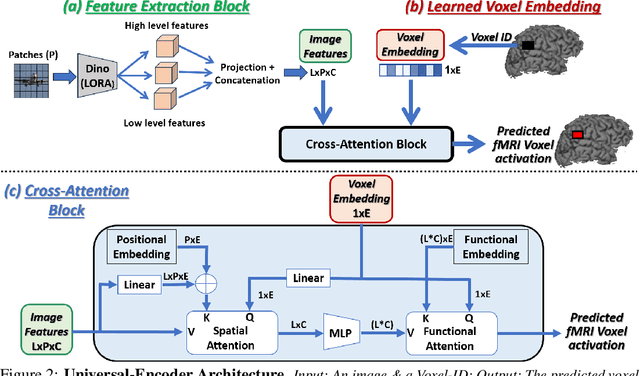
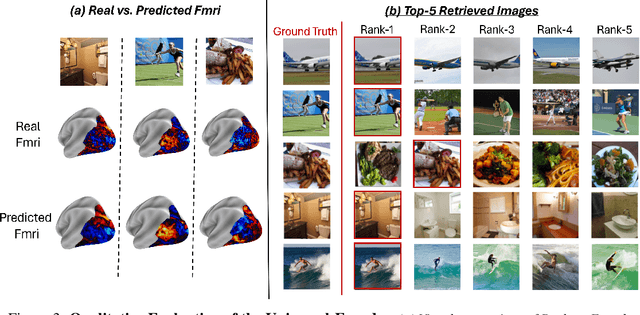

Abstract:Image-to-fMRI encoding is important for both neuroscience research and practical applications. However, such "Brain-Encoders" have been typically trained per-subject and per fMRI-dataset, thus restricted to very limited training data. In this paper we propose a Universal Brain-Encoder, which can be trained jointly on data from many different subjects/datasets/machines. What makes this possible is our new voxel-centric Encoder architecture, which learns a unique "voxel-embedding" per brain-voxel. Our Encoder trains to predict the response of each brain-voxel on every image, by directly computing the cross-attention between the brain-voxel embedding and multi-level deep image features. This voxel-centric architecture allows the functional role of each brain-voxel to naturally emerge from the voxel-image cross-attention. We show the power of this approach to (i) combine data from multiple different subjects (a "Crowd of Brains") to improve each individual brain-encoding, (ii) quick & effective Transfer-Learning across subjects, datasets, and machines (e.g., 3-Tesla, 7-Tesla), with few training examples, and (iii) use the learned voxel-embeddings as a powerful tool to explore brain functionality (e.g., what is encoded where in the brain).
Deconstructing Data Reconstruction: Multiclass, Weight Decay and General Losses
Jul 04, 2023Abstract:Memorization of training data is an active research area, yet our understanding of the inner workings of neural networks is still in its infancy. Recently, Haim et al. (2022) proposed a scheme to reconstruct training samples from multilayer perceptron binary classifiers, effectively demonstrating that a large portion of training samples are encoded in the parameters of such networks. In this work, we extend their findings in several directions, including reconstruction from multiclass and convolutional neural networks. We derive a more general reconstruction scheme which is applicable to a wider range of loss functions such as regression losses. Moreover, we study the various factors that contribute to networks' susceptibility to such reconstruction schemes. Intriguingly, we observe that using weight decay during training increases reconstructability both in terms of quantity and quality. Additionally, we examine the influence of the number of neurons relative to the number of training samples on the reconstructability.
The Hidden Language of Diffusion Models
Jun 06, 2023
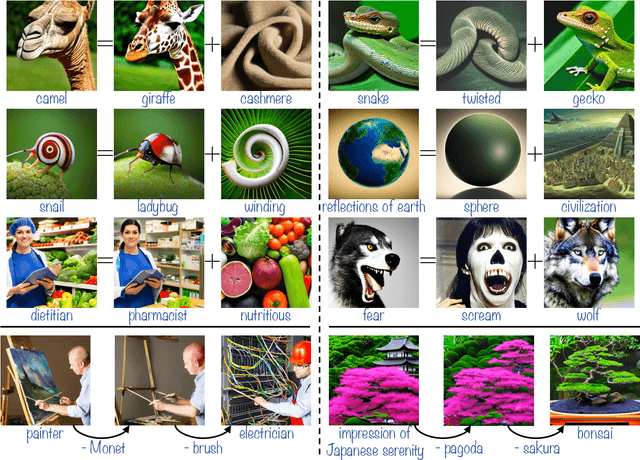
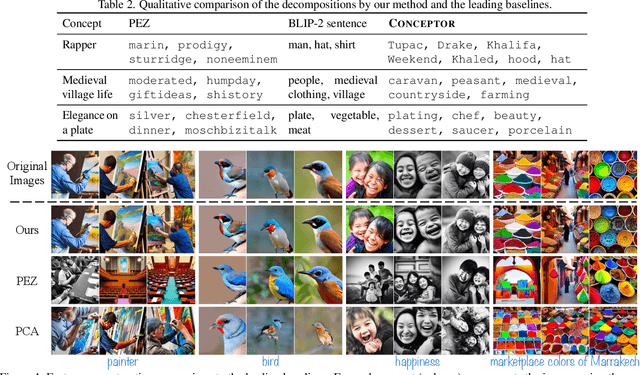
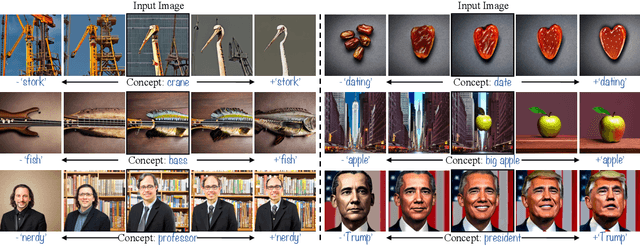
Abstract:Text-to-image diffusion models have demonstrated an unparalleled ability to generate high-quality, diverse images from a textual concept (e.g., "a doctor", "love"). However, the internal process of mapping text to a rich visual representation remains an enigma. In this work, we tackle the challenge of understanding concept representations in text-to-image models by decomposing an input text prompt into a small set of interpretable elements. This is achieved by learning a pseudo-token that is a sparse weighted combination of tokens from the model's vocabulary, with the objective of reconstructing the images generated for the given concept. Applied over the state-of-the-art Stable Diffusion model, this decomposition reveals non-trivial and surprising structures in the representations of concepts. For example, we find that some concepts such as "a president" or "a composer" are dominated by specific instances (e.g., "Obama", "Biden") and their interpolations. Other concepts, such as "happiness" combine associated terms that can be concrete ("family", "laughter") or abstract ("friendship", "emotion"). In addition to peering into the inner workings of Stable Diffusion, our method also enables applications such as single-image decomposition to tokens, bias detection and mitigation, and semantic image manipulation. Our code will be available at: https://hila-chefer.github.io/Conceptor/
Reconstructing Training Data from Multiclass Neural Networks
May 05, 2023Abstract:Reconstructing samples from the training set of trained neural networks is a major privacy concern. Haim et al. (2022) recently showed that it is possible to reconstruct training samples from neural network binary classifiers, based on theoretical results about the implicit bias of gradient methods. In this work, we present several improvements and new insights over this previous work. As our main improvement, we show that training-data reconstruction is possible in the multi-class setting and that the reconstruction quality is even higher than in the case of binary classification. Moreover, we show that using weight-decay during training increases the vulnerability to sample reconstruction. Finally, while in the previous work the training set was of size at most $1000$ from $10$ classes, we show preliminary evidence of the ability to reconstruct from a model trained on $5000$ samples from $100$ classes.
Teaching CLIP to Count to Ten
Feb 23, 2023Abstract:Large vision-language models (VLMs), such as CLIP, learn rich joint image-text representations, facilitating advances in numerous downstream tasks, including zero-shot classification and text-to-image generation. Nevertheless, existing VLMs exhibit a prominent well-documented limitation - they fail to encapsulate compositional concepts such as counting. We introduce a simple yet effective method to improve the quantitative understanding of VLMs, while maintaining their overall performance on common benchmarks. Specifically, we propose a new counting-contrastive loss used to finetune a pre-trained VLM in tandem with its original objective. Our counting loss is deployed over automatically-created counterfactual examples, each consisting of an image and a caption containing an incorrect object count. For example, an image depicting three dogs is paired with the caption "Six dogs playing in the yard". Our loss encourages discrimination between the correct caption and its counterfactual variant which serves as a hard negative example. To the best of our knowledge, this work is the first to extend CLIP's capabilities to object counting. Furthermore, we introduce "CountBench" - a new image-text counting benchmark for evaluating a model's understanding of object counting. We demonstrate a significant improvement over state-of-the-art baseline models on this task. Finally, we leverage our count-aware CLIP model for image retrieval and text-conditioned image generation, demonstrating that our model can produce specific counts of objects more reliably than existing ones.
SinFusion: Training Diffusion Models on a Single Image or Video
Nov 21, 2022Abstract:Diffusion models exhibited tremendous progress in image and video generation, exceeding GANs in quality and diversity. However, they are usually trained on very large datasets and are not naturally adapted to manipulate a given input image or video. In this paper we show how this can be resolved by training a diffusion model on a single input image or video. Our image/video-specific diffusion model (SinFusion) learns the appearance and dynamics of the single image or video, while utilizing the conditioning capabilities of diffusion models. It can solve a wide array of image/video-specific manipulation tasks. In particular, our model can learn from few frames the motion and dynamics of a single input video. It can then generate diverse new video samples of the same dynamic scene, extrapolate short videos into long ones (both forward and backward in time) and perform video upsampling. When trained on a single image, our model shows comparable performance and capabilities to previous single-image models in various image manipulation tasks.
Imagic: Text-Based Real Image Editing with Diffusion Models
Oct 17, 2022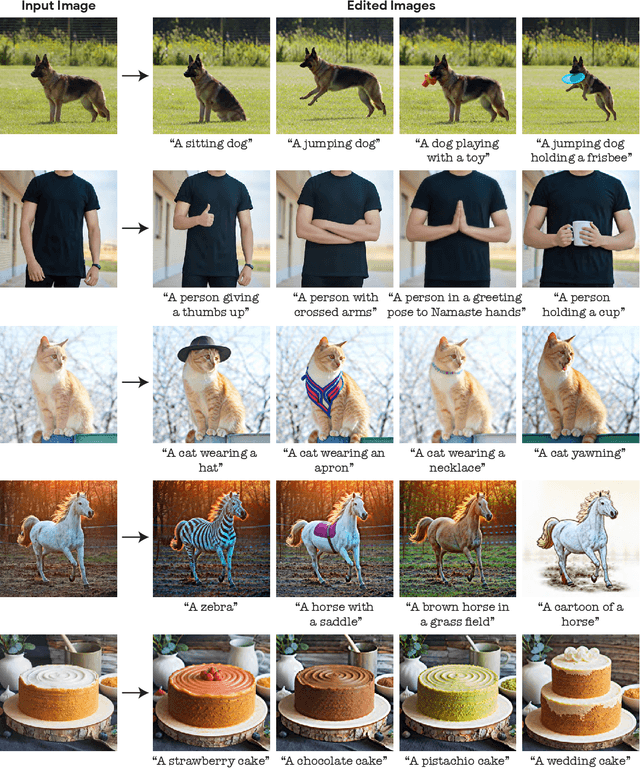

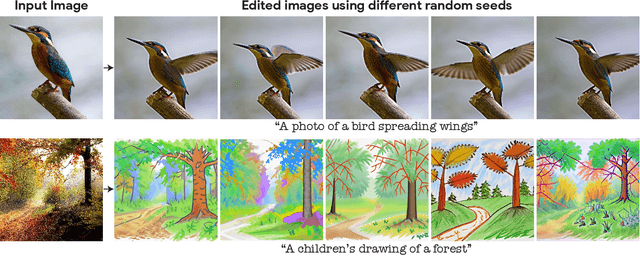

Abstract:Text-conditioned image editing has recently attracted considerable interest. However, most methods are currently either limited to specific editing types (e.g., object overlay, style transfer), or apply to synthetically generated images, or require multiple input images of a common object. In this paper we demonstrate, for the very first time, the ability to apply complex (e.g., non-rigid) text-guided semantic edits to a single real image. For example, we can change the posture and composition of one or multiple objects inside an image, while preserving its original characteristics. Our method can make a standing dog sit down or jump, cause a bird to spread its wings, etc. -- each within its single high-resolution natural image provided by the user. Contrary to previous work, our proposed method requires only a single input image and a target text (the desired edit). It operates on real images, and does not require any additional inputs (such as image masks or additional views of the object). Our method, which we call "Imagic", leverages a pre-trained text-to-image diffusion model for this task. It produces a text embedding that aligns with both the input image and the target text, while fine-tuning the diffusion model to capture the image-specific appearance. We demonstrate the quality and versatility of our method on numerous inputs from various domains, showcasing a plethora of high quality complex semantic image edits, all within a single unified framework.
 Add to Chrome
Add to Chrome Add to Firefox
Add to Firefox Add to Edge
Add to Edge